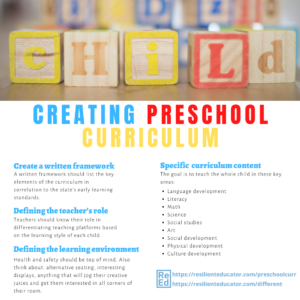
You don’t need us to tell you how important it is to create an excellent preschool curriculum—that’s why you’re here, after all. It’s your role (or if you’re an administrator, your staff’s role) to create a learning environment that starts children down a road toward academic success, to enhance preschoolers’ skills and knowledge using evidence-based classroom techniques. And, of course, it helps teachers love their job more when those toddlers love coming to class!
For basic steps in creating a preschool curriculum that’s appropriate for 3 and 4 year-old students, read on.
Create a written framework
A written framework should list the key elements of the curriculum in correlation to the state’s early learning standards. Writing out the framework each year allows the teaching staff to find common ground on educational theory, as well as incorporates the latest techniques and research into the curriculum.
When developing curriculum structure, list the goals for children in all required elements as defined by the state’s early learning standards. Define early learning goals for the entire preschool program and include relevant research on childhood development that helps establish the curriculum. The written framework is a guideline for teachers to use and should offer preschool educators current information on intentional play, simple to complex teaching, and factors that influence social skills.
Defining the teacher’s role
Defining the role a teacher plays is a critical part in developing the written curriculum framework. Teachers are responsible for creating engaging interaction and strategies to encourage learning. Instructing these educators on expectations will aid them as they design specific lessons for their classes.
Administrators should provide information on the balance of group experiences in each class; a mix of small, medium, and large sessions encourages individualized development and varied social skills. The framework must address how to balance teacher-directed activities with child-initiated play.
Teachers should know their role in differentiating teaching platforms based on the learning style of each child. Preschoolers certainly do not all learn at the same rate—this framework should address how teachers make distinctions.
Defining the learning environment
We’re big on the fact that for children to learn effectively, their health and safety should be top of mind—as much as their education is. The classroom environment for preschoolers should be a safe, creative landscape that enhances the learning process. The final stage of framework development deals with room structure and scheduling in classrooms.
Use this section to discuss why developing a positive environment is vital to healthy learning. Offer ways to incorporate both indoor and outdoor activities into the schedule. Provide information on supplies and materials considered developmentally appropriate for preschool classrooms. And think about the details: alternative seating, interesting displays, anything that will jog their creative juices and get them interested in all corners of their room.
Tips for specific preschool curriculum content
After the completion of the base curriculum framework, teachers can work toward planning their individual lesson projects. Current trends in preschool education aim for a comprehensive approach, explains the Houghton Mifflin Harcourt Education Place. The goal is to teach the whole child in these key areas:
- Language development
- Literacy
- Math
- Science
- Social studies
- Art
- Social development
- Physical development
- Culture development
Because young children learn better from hands-on activities then they do in lecture environments (can you imagine a circle time that went on for hours?!), teachers should use big ideas to help develop vocabulary while establishing the child’s interest in science, math, and art. For example, lessons in dinosaurs offer information about history, animals, and nature while enriching the child’s vocabulary.
And at this age, focus on literacy, not reading, for teaching assignments. Teachers want to establish the importance of vocabulary and listening at this early age. This helps foster a love of reading as the child enters the elementary level classes.
Have fun with it
The goal is to make the most of those early years to foster a lifetime love of learning. To accomplish that, students—especially preschoolers—should have a good time in the process. If you have fun creating the curriculum, there’s a good chance they will too.
Categorized as: Tips for Teachers and Classroom Resources
Tagged as: Curriculum and Instruction, Early Childhood and Elementary (Grades: PreK-5)

